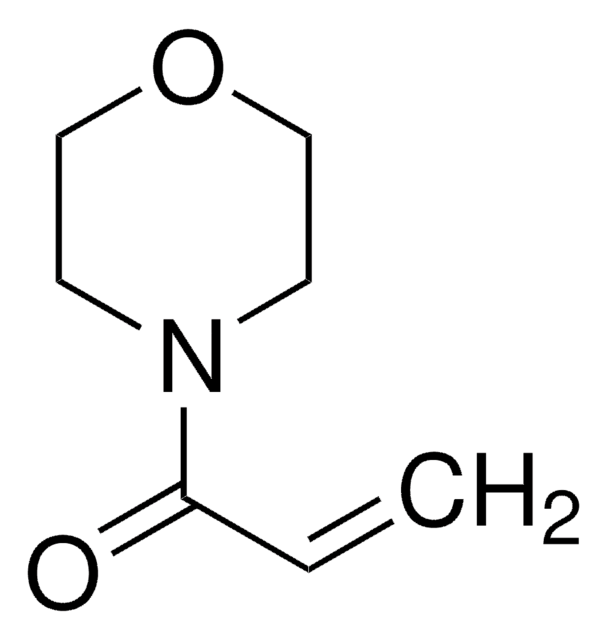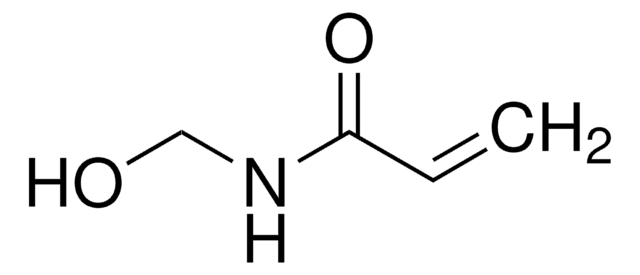If this product has an expiration or retest date, it will be shown on the Certificate of Analysis (COA, CofA). If there is no retest or expiration date listed on the product's COA, we do not have suitable stability data to determine a shelf life. For these products, the only date on the COA will be the release date; a retest, expiration, or use-by-date will not be displayed.
For all products, we recommend handling per defined conditions as printed in our product literature and website product descriptions. We recommend that products should be routinely inspected by customers to ensure they perform as expected.
For products without retest or expiration dates, our standard warranty of 1 year from the date of shipment is applicable.
For more information, please refer to the Product Dating Information document: https://www.sigmaaldrich.com/deepweb/assets/sigmaaldrich/marketing/global/documents/449/386/product-dating-information-mk.pdf
697931
N-Hydroxyethyl acrylamide
contains 1,000 ppm monomethyl ether hydroquinone as stabilizer, 97%
Sinónimos:
N-(2-Hydroxyethyl)acrylamide, HEAA
Seleccione un Tamaño
Seleccione un Tamaño
About This Item
Productos recomendados
Nivel de calidad
Ensayo
97%
Formulario
liquid
contiene
1,000 ppm monomethyl ether hydroquinone as stabilizer
índice de refracción
n20/D 1.505
bp
129-130 °C
densidad
1.111 g/mL at 25 °C
temp. de almacenamiento
2-8°C
cadena SMILES
OCCNC(=O)C=C
InChI
1S/C5H9NO2/c1-2-5(8)6-3-4-7/h2,7H,1,3-4H2,(H,6,8)
Clave InChI
UUORTJUPDJJXST-UHFFFAOYSA-N
Categorías relacionadas
Aplicación
- preparation of hydrogels for the formation of a stimulo-responsive polymer for cell signaling and bioengineering research[1]
- in the synthesis of lanthanide based luminescent materials for sensors and bio-imaging[2]
- formation of adhesive hydrogel for potential usage in the smart adhesives[3]
Palabra de señalización
Danger
Frases de peligro
Consejos de prudencia
Clasificaciones de peligro
Eye Dam. 1 - STOT RE 2 Oral
Código de clase de almacenamiento
10 - Combustible liquids
Clase de riesgo para el agua (WGK)
WGK 1
Punto de inflamabilidad (°F)
298.4 °F - closed cup
Punto de inflamabilidad (°C)
148 °C - closed cup
Equipo de protección personal
Eyeshields, Faceshields, Gloves, type ABEK (EN14387) respirator filter
Elija entre una de las versiones más recientes:
¿Ya tiene este producto?
Encuentre la documentación para los productos que ha comprado recientemente en la Biblioteca de documentos.
Los clientes también vieron
-
How can I determine the shelf life / expiration / retest date of this product?
1 answer-
Helpful?
-
-
How is shipping temperature determined? And how is it related to the product storage temperature?
1 answer-
Products may be shipped at a different temperature than the recommended long-term storage temperature. If the product quality is sensitive to short-term exposure to conditions other than the recommended long-term storage, it will be shipped on wet or dry-ice. If the product quality is NOT affected by short-term exposure to conditions other than the recommended long-term storage, it will be shipped at ambient temperature. As shipping routes are configured for minimum transit times, shipping at ambient temperature helps control shipping costs for our customers. For more information, please refer to the Storage and Transport Conditions document: https://www.sigmaaldrich.com/deepweb/assets/sigmaaldrich/marketing/global/documents/316/622/storage-transport-conditions-mk.pdf
Helpful?
-
-
N-ヒドロキシエチルアクリルアミドは水に溶解しますか?また、下限臨界溶液温度は何度くらいでしょうか?
1 answer-
Per the product's SDS, its water solubility is 1,000 g/l at 20 °C. However, details about its lower critical solution temperature are not tested or provided.
Helpful?
-
Active Filters
Nuestro equipo de científicos tiene experiencia en todas las áreas de investigación: Ciencias de la vida, Ciencia de los materiales, Síntesis química, Cromatografía, Analítica y muchas otras.
Póngase en contacto con el Servicio técnico






![N-[Tris(hydroxymethyl)methyl]acrylamide contains ≤7% KCl, 93%](/deepweb/assets/sigmaaldrich/product/structures/130/961/5bc6d1a4-a540-4496-9f46-74507af67e21/640/5bc6d1a4-a540-4496-9f46-74507af67e21.png)





